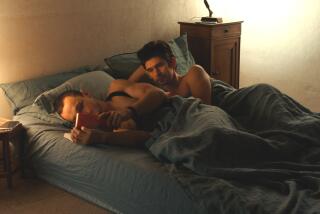‘Hounddog’ finds a home
- Share via
Writer-director Deborah Kampmeier was nearly run out of Park City, Utah, during last year’s Sundance Film Festival after critics savaged her coming-of-age drama “Hounddog,” in which a 12-year-old girl, played by Dakota Fanning, is raped by a much older boy.
Even before the film’s premiere, such conservative groups as the Christian Film & Television Commission and the Catholic League for Religious and Civil Rights strongly objected to the scene.
“People were petitioning to have me arrested for child pornography,” Kampmeier says. “There were petitions to have Dakota’s mother arrested. We had a bodyguard at the Sundance screening. There were death threats against me. Dakota gives a remarkable performance, and she’s being shamed for having done this role. It was so painful to see people attacking her that way.”
Over the years, other filmmakers have run into problems with their movies dealing with sensitive issues involving children, including Anjelica Huston’s 1996 pedophile drama “Bastard Out of Carolina” and Louis Malle’s “Pretty Baby” (1978), in which a preteen Brooke Shields plays a child prostitute in New Orleans. But those complaints seem mild compared with the firestorm surrounding “Hounddog.”
Kampmeier insists she wasn’t courting controversy.
“I didn’t make it to make a social commentary,” she says. “I wrote it from my heart, and if it touches someone else’s heart now that it has become a controversial film and is dealing with a lot of social issues . . . I am really trying to embrace that.”
Truth be told, the rape sequence, though harrowing, is discreetly shot. Kampmeier says Fanning (“I Am Sam,” “Charlotte’s Web”) was protected during the filming. “It was carefully orchestrated,” she says. “You are crafting it in the editing room.”
“Hounddog,” set in rural Alabama during the late 1950s, was considered too much of a hot potato to attract a distributor after Sundance. But earlier this year, a small, relatively new company, Empire Film Group, acquired it and will open the film Friday in limited release, including in Los Angeles.
But it was a different aspect of the Sundance experience that inspired Kampmeier to take another pass at the rough-cut version she screened there. The responses at the public screenings, Kampmeier says, were far removed from the critics’ reactions.
“I had lines of women who came up in tears thanking me for making the film,” she says. “I had women stand up in the Q&As; mothers who had literally seen it the day before brought their 13-year-old daughters to see it. I had a man come up to me after a screening and say he hadn’t cried his entire life but this made him cry. Those responses really gave me the courage to continue to trust my voice and my vision when I went back to continue working on the film.”
The Sundance version of “Hounddog,” says the filmmaker, was more about action; the release cut is more about reaction. “I had time to go in and dig into the performances and let these incredible actors tell the story. Fifty percent of the footage is different . . . because we went in and chose the performances. I think the film is much more nuanced.”
Structurally, the biggest change occurs after Fanning’s character, Lewellen, is raped. “What I wanted to focus on was what was important to me -- her voice was silenced and her spirit was silenced. So I decided to move all the scenes after the rape so she doesn’t say a word after the rape until she screams at her father,” played by David Morse.
Empire Films believes in the new version too. “We knew there was a lot of negative publicity,” says Eric Parkinson, chief executive of distribution for Empire. “But we predicated our deal not on the Sundance cut; we made it on the new cut, which is substantially different. We thought the film’s reputation was not deserved.”
--
More to Read
The biggest entertainment stories
Get our big stories about Hollywood, film, television, music, arts, culture and more right in your inbox as soon as they publish.
You may occasionally receive promotional content from the Los Angeles Times.











